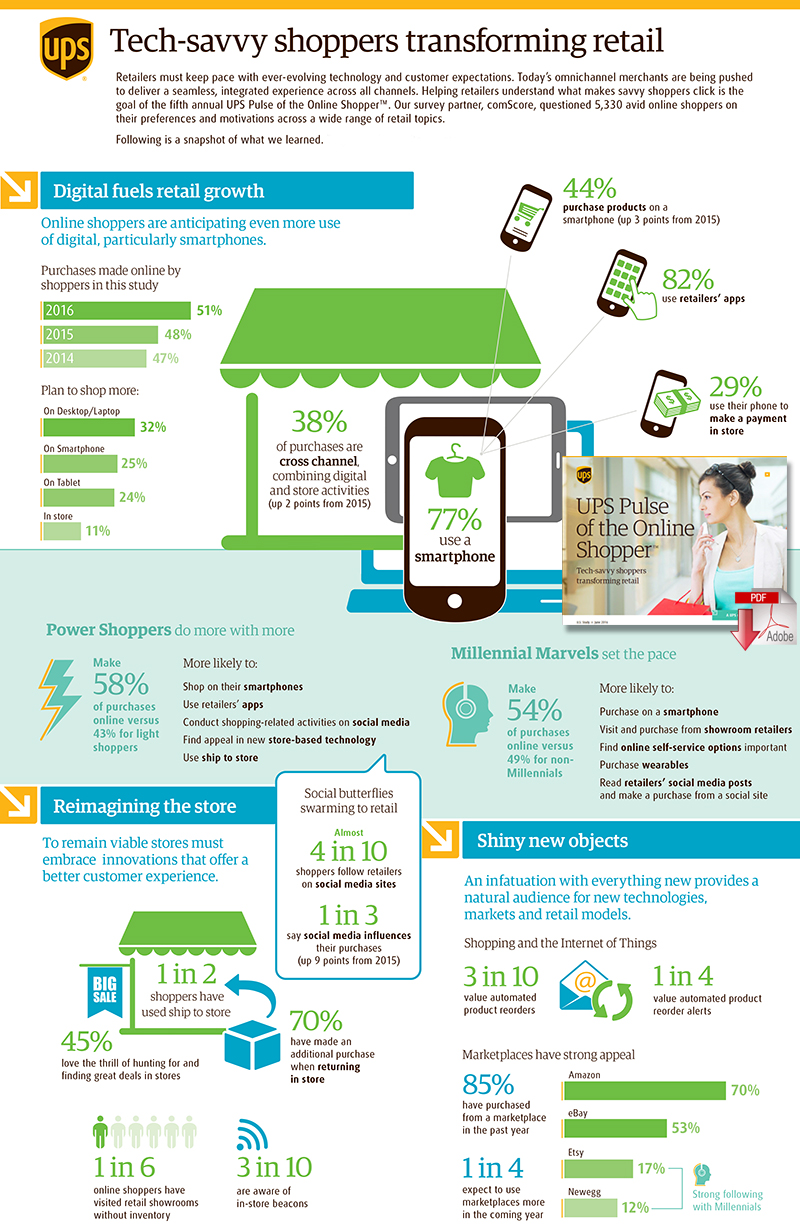UPS Study Highlights Impact of Active Online Shoppers on Supply Chain

Tech-savvy shoppers and new technologies are changing the retail industry, from the growth of mobile shopping to retailer adoption of in-store beacons and mobile messaging, technology is quickly becoming a game-changer in the e-commerce experience.
It is not even close to a secret that e-commerce is changing the way consumers buy goods.
What may be somewhat surprising, though, is that more than 50 percent of online purchases are now being made online.
That was a key takeaway from the fifth annual UPS Pulse of the Online Shopper Global Study issued this week by UPS and comScore Inc.
Data used in the study was based on feedback from 5,330 avid online shoppers that made at least two transactions in a three-month period on their preference and motivations across various retail topics.
With 51 percent of respondents’ purchases now being made online, it continues a trend that has been intact in recent years, according to Louis DeJianne, UPS Director of Consumer Goods and Retail Marketing, in an interview.
“It is really a continuation of the trend of the last three years, which came in at 47 percent, 48 percent, and now 51 percent and speaks to the way retailers are embracing online shoppers and also the increased usage of smart phone and tablets for shopping,” he said.
“Retailers have really made that process easier, and people are becoming more acceptable of the checkout process and making online payments. As the retailers make this process easier for consumers, they will gravitate to it more. And with consumers spending more time and making more purchases on their phones, making purchases becomes easier and more efficient for us.”
That point was made clear in the study, with smart phone usage up 10 points to 77 percent over the last two years, coupled with online shoppers reporting a better mobile experience with satisfaction up 8 points to 73 percent.
Ship to store: The concept of shipping to retail store locations received a fair amount of attention in the study.
50 percent of respondents said they have shipped to a store for pickup, with 46 percent of those saying that they have made additional purchases in stores. As for future growth on this front, 27 percent of online shoppers plan to use ship to store more in the coming year, with 44 percent of past ship-to-store users planning to do the same.
Going forward, DeJianne said this portends how retailers are trying to determine what stores will look like in the future, which is front and center with several brick and mortar stores closing down due to a challenging environment.
“Redefining what a store looks like is becoming critical to retailers, and one way to drive more consumers to stores is through ship to store programs,” he explained.
“If I am a retailer working on a ship to store program, there also needs to be a way to offer free shipping, so if I am a consumer at home and I want to order something now I can offer the retailer free shipping or ship to store, which is going to cost money potentially to ship to a consumer’s home so that is going to push more consumers to the store. As the study shows, once consumers are in the store, they have a tendency to buy more products.”
Returns: Not surprisingly, the study found that returns are three times more prevalent for online retailers and have been on the low end of customer satisfaction during the duration of this study.
The four categories of returns saw modest gains this year, with: clear and easy return policy up from 66 to 67 percent; ease of making returns/exchanges in store up from 65 to 67 percent; ability to process a return/exchange online up from 62 to 65 percent; and ease of shipping product back to retailer up from 61 to 63 percent.
What’s more, the study found that 72 percent of shoppers return 10 percent or less of purchases, and 8 percent of shoppers return 26 percent or more of purchases.
DeJianne said part of this relates back to the frequency of purchases by consumers. As an example, he said if a consumer buys sneakers, an order may be placed for three pairs, with the consumer sending back the ones that don’t fit, which, in turn, drives up return levels.
“This makes returns processes critical for consumers, and what retailers need to do is ensure consumers are comfortable with returns processes before making orders, and retailers have gotten better at displaying items to consumers at the time of purchase,” he said.
“Retailers are working on displaying clear concise pictures of their product or showing it in a way that someone is wearing or using it. Customer reviews are also important, so that upfront process has gotten better and so has the back end for returns.”
Delivery options: While the two-day delivery offered to Amazon Prime members, there are numerous other options available to consumers, too, as outlined in the study, with the average shopper willing to wait up to six days when they pay for shipping and seven days for free shipping.
The study explained that it is key for retailers to offer delivery speed options as customers have been “conditioned to push the envelope on faster delivery times” and extending window deadlines for next-day and same-day delivery.
“What we try to provide to our customers is choice for things they can control,” said DeJianne.
“It may be that if a consumer needs something very soon, he may be willing to pay for the transportation of the order so it arrives as needed. On the other end, there may be an order not needed for 14 days from now, so there is no reason to pay for shipping and can instead go the free shipping route. When displaying shipping options to the end consumer, choices are really based on where they are in that buying process.”
Article Topics
UPS News & Resources
Amazon Logistics’ Growth Shakes Up Shipping Industry in 2023 FedEx and UPS to Charge Additional Delivery Fees in Major U.S. Cities Parcel Experts Weigh in on New Partnership Between UPS and USPS Parcel experts examine the UPS-United States Postal Service air cargo relationship amid parcel landscape UPS To Become USPS’s Main Air Cargo Provider, Replacing FedEx UPS is set to take over USPS air cargo contract from FedEx GRI Impact Analysis – Parcel Spend Management 1.0 vs. 2.0 More UPSLatest in Supply Chain
Microsoft Unveils New AI Innovations For Warehouses Let’s Spend Five Minutes Talking About ... Malaysia Baltimore Bridge Collapse: Impact on Freight Navigating TIm Cook Says Apple Plans to Increase Investments in Vietnam Amazon Logistics’ Growth Shakes Up Shipping Industry in 2023 Spotlight Startup: Cart.com is Reimagining Logistics Walmart and Swisslog Expand Partnership with New Texas Facility More Supply ChainAbout the Author
















